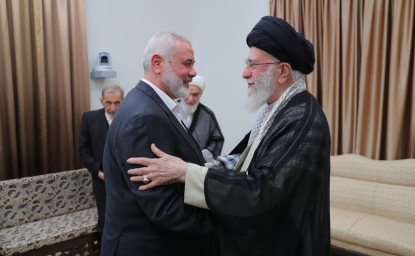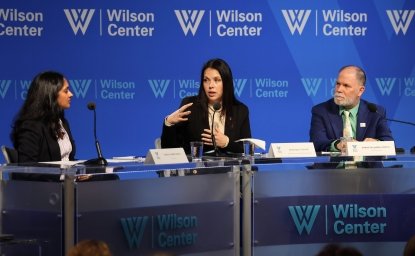By Cameron Glenn
Al Qaeda and ISIS draw on similar schools of thought. Both are inspired by the works of medieval scholar Ibn Taymiyya, 20th century Egyptian ideologue Sayyid Qutb, and later scholars, such as Abu Muhammad al Maqdisi, a Palestinian-Jordanian who taught former al Qaeda in Iraq leader Abu Musab al Zarqawi. Both groups claim their hardline interpretations are reviving the purity of the faith when it was founded in the seventh century. But most influential jihadist ideologues, including Maqdisi, have remained loyal to al Qaeda.
ISIS has tried to cultivate its own scholarly resources to boost its profile. ISIS scholars tend to be younger than those loyal to al Qaeda. The 30-year-old Bahraini Turki al Bin’ali is among ISIS’s most prominent scholars. In 2013, he wrote a biography of Baghdadi that claimed Baghdadi was a descendent of the Prophet Mohammed.
Despite ideological similarities, the two groups differ in strategy on a few key points—on enemies, the use of violence, minorities, and use of the media.
The West
In their pronouncements, both al Qaeda and ISIS have targeted the West. But al Qaeda places a stronger emphasis on ridding any trace of Western influence from Muslim lands.
Al Qaeda
ISIS
“The ruling to kill the Americans and their allies -- civilians and military -- is an individual duty for every Muslim who can do it in any country in which it is possible to do it, in order to liberate the al-Aqsa Mosque and the holy mosque [Mecca] from their grip, and in order for their armies to move out of all the lands of Islam, defeated and unable to threaten any Muslim. This is in accordance with the words of Almighty Allah, ‘and fight the pagans all together as they fight you all together,’ and ‘fight them until there is no more tumult or oppression, and there prevail justice and faith in Allah.’”– Osama bin Laden’s 1998 fatwa against the United States
“We have declared jihad against the US, because in our religion it is our duty to make jihad so that God's word is the one exalted to the heights and so that we drive the Americans away from all Muslim countries.” –Statement by Osama bin Laden, 1997
In practice:
Since the 1990s, Al Qaeda has mainly targeted the West, which it accuses of propping up corrupt Arab regimes. According to al Qaeda, a caliphate cannot be established until Western forces are defeated and expelled from Muslim countries.
“Be very wary of allying with the Jews and Christians, and whoever has slipped by a word, then let him fear Allah, renew his faith, and repent from his deed. […] Even if he supported them just by a single word. He who aligns with them by a single word falls into apostasy– extreme apostasy.” - Issue # 4 of ISIS's “Dabiq” magazine, October 2014
“The world today has been divided into two camps and two trenches, with no third camp present: The camp of Islam and faith, and the camp of kufr (disbelief) and hypocrisy – the camp of the Muslims and the mujahidin everywhere, and the camp of the Jews, the crusaders, their allies, and with them the rest of the nations and religions of kufr, all being led by America and Russia, and being mobilized by the Jews.” - July 1, 2014, in a speech by Baghdadi
In practice:
Like al Qaeda, ISIS has a strongly anti-Western worldview. Baghdadi has urged Muslims around the world to rise up and avenge injustices inflicted by the West. ISIS has publicly beheaded Western hostages. But most of its victims have been local.
Minorities
Both al Qaeda and ISIS denounce Shiites, Christians, and virtually any group that doesn’t share their worldview. But al Qaeda leaders have emphasized that attacking these groups is not the highest priority, while ISIS has carried out mass killings of minorities in its territories.
Al Qaeda
ISIS
“People of discernment and knowledge among Muslims know the extent of danger to Islam of the 12’er school of Shi’ism. It is a religious school based on excess and falsehood whose function is to accuse the companions of Muhammad of heresy [in] a campaign against Islam, in order to free the way for a group of those who call for a dialogue in the name of the hidden Mahdi who is in control of existence and infallible in what he does. Their prior history in cooperating with the enemies of Islam is consistent with their current reality of connivance with the crusaders.” - Zawahiri’s 2005 letter to Abu Musab al Zarqawi
“As for the sectarian and chauvinistic factor, it is secondary in importance to outside aggression, and is much weaker than it.” - Zawahiri’s 2005 letter to Abu Musab al Zarqawi
In practice:
Al Qaeda, which is dominated by Sunni Muslims, is vehemently anti-Shiite. But its leaders have emphasized that sectarian warfare is less of a priority than fighting the West.
“Their creed [of Yazidis] is so deviant from the truth that even cross-worshipping Christians for ages considered them devil worshippers and Satanists.”- Issue # 4 of ISIS's “Dabiq” magazine, October 2014
"Terrorism is to worship Allah as He ordered you…Terrorism is to insist upon your rights and not give them up...Terrorism does not include the extreme torture and degradation of Muslims in East Turkistan and Iran (by the rafidah)*, as well as preventing them from receiving their most basic rights."
*"Rafidah" is a pejorative term for Shiites
- Abu Bakr al Baghdadi, in a July 2014 speech
In practice:
ISIS has primarily focused on local targets, attacking anyone in Iraq and Syria that does not agree with its worldview – regime forces, Shiites, Yazidis, Christians, and even other jihadists.
Its sectarian focus dates back to the early 2000s. Under the leadership of Abu Musab al Zarqawi, ISIS – then known as Al Qaeda in Iraq – attacked Shiites and fellow Sunnis.
Violence
Both al Qaeda and ISIS have carried out attacks against Muslim and non-Muslim civilians. But al Qaeda focuses on high-profile attacks against Western targets, fearing that sectarian attacks could alienate potential Muslim allies. ISIS, however, has carried out mass killings of Shiites, Yazidis, and other minorities.
Al Qaeda
ISIS
“Among the things which the feelings of the Muslim populace who love and support you will never find palatable…are the scenes of slaughtering the hostages.”
“Many of your Muslim admirers amongst the common folk are wondering about your attacks on the Shia. The sharpness of this questioning increases when the attacks are on one of their mosques...My opinion is that this matter won't be acceptable to the Muslim populace however much you have tried to explain it, and aversion to this will continue.” – Zawahiri’s 2005 letter to Abu Musab al Zarqawi
“We treat others like they treat us…those who kill our women and our innocent, we kill their women and innocent.”– Osama bin Laden statement, 2001
In practice:
Al Qaeda has focused on spectacular attacks to provoke world attention. It has justified killing civilians as retribution for attacks by Western forces.
Like ISIS, al Qaeda has had little tolerance for Shiites and other minorities outside its narrow worldview. But the group has acknowledged that mass sectarian killings and excessive brutality detract from its goal of attacking the West and alienate potential followers. In 2005, al Qaeda leaders warned Zarqawi against carrying out sectarian attacks that could provoke a backlash among fellow Sunnis.
The March 2015 attacks on two Shiite mosques in Yemen reflected the contrast between al Qaeda and ISIS. Sanaa Province, an ISIS affiliate, claimed responsibility for the attacks. AQAP, al Qaeda’s Yemeni affiliate, denied involvement, reaffirming commitment to Zawahiri’s guidelines to avoid attacks on mosques and other areas that target Muslims.
“[American hostage Steven Sotloff’s] killing was the consequence of US arrogance and transgression which all US citizens are responsible for as they are represented by the government they have elected, approved of, and supported, through votes, polls, and taxes.”- Issue #4 of ISIS's "Dabiq" magazine, October 2014
"By using methods that led to maximum chaos and targeting apostates of all different backgrounds, the mujahidin were able to keep Iraq in constant instability and war, never allowing any apostate group to enjoy a moment of security.” - Issue #1 of ISIS's "Dabiq" magazine, July 2014
In practice:
ISIS has focused on its battlefield gains and other attacks against a wide range of targets in Iraq and Syria. ISIS has engaged in brutal mass killings of Yazidis, Shiites, and other groups in its territory. Militants invaded Yazidi communities in Sinjar in August 2014, killing those who refused to convert and driving tens of thousands from their homes. ISIS has also killed Shiites in newly captured territories.
ISIS has reportedly kidnapped, raped, and sold women and children who are deemed unbelievers, most notably Yazidis. In late 2014, ISIS released a pamphlet justifying enslavement of non-Muslim women and children.
ISIS has beheaded prisoners and posted images of their bodies on social media to raise its profile and gain international attention. Unlike al Qaeda, ISIS has also engaged in more conventional warfare in clashes with other armed groups over control of territory.
Use of Media
The generation gap between al Qaeda and ISIS is reflected in disparate communications tactics and outreach. Both have launched English-language magazines to attract Western recruits, but each has focused on different content.
Al Qaeda
ISIS
“As our responsibility to the Muslim Ummah in general and Muslims living in America in particular, Inspire Magazine humbly presents to you a simple improvised home recipe of a car bomb. And the good news is… you can prepare it in the kitchen of your mom too.” - From a 2014 issue of al Qaeda’s Inspire magazine
In practice:
Al Qaeda’s English language magazine, known as “Inspire”, was started in 2010 by Anwar al Awlaki, an American jihadist killed in a U.S. drone strike in 2011. New issues of the magazine continued to be published after his death.
The magazine has focused primarily on providing instructions on carrying out attacks against Western targets. But it has not articulated a broader political or military strategy.
On the internet, al Qaeda has primarily relied on conventional media — including older mechanisms, such as jihadist forums and websites — to propagate its message.
“The Islamic State is facing a growing list of enemies, and it further underscores the fact that the lines are being drawn and the camps of īmān (believers) and kufr (non-believers) are both being cleansed. This will eventually lead to a camp of kufr with no trace of īmān, and a camp of īmān with no trace of hypocrisy, as per the statement of the Prophet...all parties will soon be forced to make a choice between the two.” - Issue # 4 of ISIS's Dabiq magazine, October 2014
In practice:
ISIS’s English language magazine, known as “Dabiq,” was first released in July 2014 after ISIS seized Mosul, Iraq. It has served as a platform for ISIS to promote its ideology and laud its own battlefield successes. It has focused more on religious justification for its actions than "Inspire."
ISIS members have tended to be younger than those in al Qaeda. Recruitment efforts have targeted young Muslims between the ages of 18 and 35. ISIS has used social media platforms, including Twitter, Facebook, Instagram, and other programs that typically reach a younger audience. By March 2015, there were at least 46,000 pro-ISIS Twitter accounts, according to the Brookings Institution.
Author

The Islamists
Learn more about Hamas and how it relates to similarly aligned organizations throughout the region. Read more

Explore More
Browse Insights & Analysis
Israel Escalates Attacks in Gaza: What’s Next?

Israel Expands Operations on Multiple Fronts: Perspectives on the Conflict

